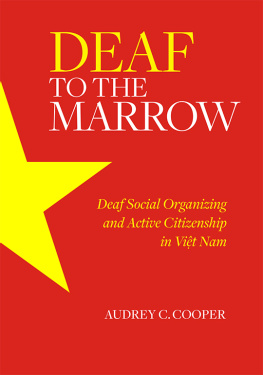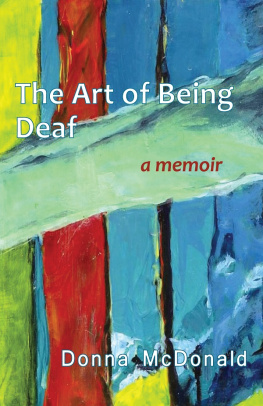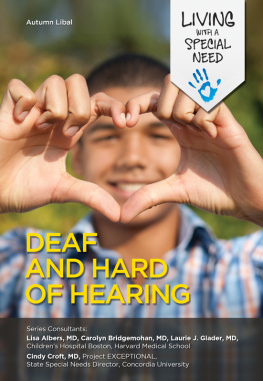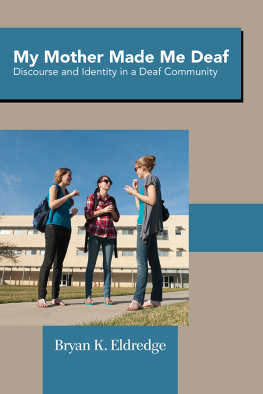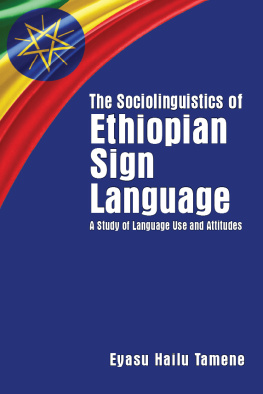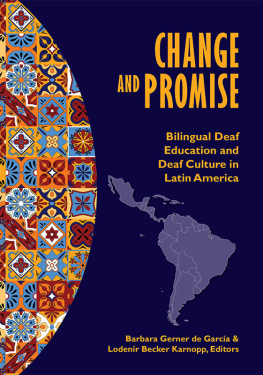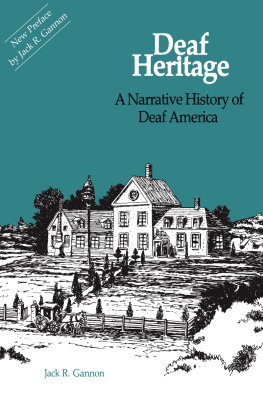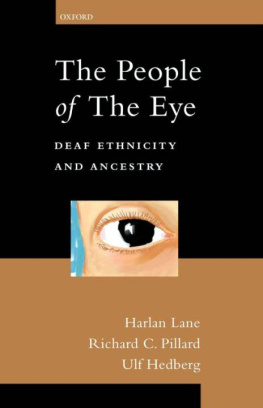Copyright 2017. Gallaudet University Press. All rights reserved. May not be reproduced in any form without permission from the publisher, except fair uses permitted under U.S. or applicable copyright law.
EBSCO Publishing : eBook Collection (EBSCOhost) via
AN: 1602583 ; Audrey C. Cooper.; Deaf to the Marrow : Deaf Social Organizing and Active Citizenship in Viet Nam
Deaf to the Marrow
Deaf Social Organizing and Active Citizenship in Vit Nam
Audrey C. Cooper
Gallaudet University Press
Washington, DC
Gallaudet University Press
Washington, DC 20002
http://gupress.gallaudet.edu
2017 by Gallaudet University
All rights reserved.
Published 2017
Printed in the United States of America
Library of Congress Cataloging-in-Publication Data
Names: Cooper, Audrey C., author.
Title: Deaf to the marrow : deaf social organizing and active citizenship in Viet Nam/Audrey C. Cooper.
Description: Washington, DC : Gallaudet University Press, [2017] | Includes bibliographical references and index.
Identifiers: LCCN 2016057558 |
ISBN 9781563686856 (hardcover : alk. paper) |
ISBN 9781563686863 (e-book)
Subjects: LCSH: DeafVietnamPolitical activity. | Social participationVietnam.
Classification: LCC HV2380 .C65 2017 | DDC 305.9/08209597dc23
LC record available at https://lccn.loc.gov/2016057558
This paper meets the requirements of ANSI/NISO Z39.48-1992 (Permanence of Paper).
This book is dedicated to my father, whose passion for understanding and sustaining the planetwater, forests, plants, people, animals, reptiles, and insectsshowed me the meaning of love and the importance of advocacy.
Contents
Foreword
Nguyn Trn Thy Tin
IN VIt NAM, Deaf people strive daily to participate in Vietnamese society and to create those conditions that will support Vietnamese signed languagesin education, employment, and community associations. In the 1980s the Vietnamese government began opening special schools for Deaf students; since that time, parents have enrolled their Deaf children in classes, often paying additional fees for that education, in the hope that their children might learn to speak Vietnamese. Educators and parents have also sought the advice of experts in this endeavor. Meanwhile, Deaf students have labored in classrooms that provide little or no language access. This is still the case today.
There are few government officials that support Vietnamese signed languages. Yet, compared with even five years ago, there has been an noticeable increase in government and public interest in Deaf people. Despite such changes, Deaf peoples education, work achievements, and social successes still make news in Vit Nam. Our accomplishments are considered unusual and surprising. This is unfair to Deaf people.
Deaf people have already contributed to many activities in Vit Nam: educational programming, language policy and planning, employment training, research projects, and the production of Vietnamese cultural arts, including dance, film, and digital media. In order to contribute more of our knowledge, skills, and creativity, Deaf social leaders ask that hearing people in Vit Namand Deaf and hearing supporters around the worldthink deeply about the barriers that keep us from taking an equal place in Vietnamese society today. Learn about our experiences and support our leadershipnot just in Deaf community activities but in every part of society.
This book contributes to our effort to share our experiences and to increase support for Deaf leadership in Vit Nam. As you read this book you will develop your own understanding of the circumstances of Deaf peoples lives in Vit Nam. We hope that you will support sign languagebased Deaf education that teaches the full national curriculum up to the 12th grade in a Vietnamese signed language. When Deaf students have access to their natural language early on, and a full education, they can excel academically and become leaders in their chosen professions. Right now we need more Deaf people who have a college or university education. We need Deaf teachers working in primary schools through to the college level. We need Deaf teachers who can teach Vietnamese signed languages and those who can teach VSL(s)-Vietnamese interpretation. We also need administrators who can supervise schools and influence policy.
We look forward to translations of this book into VSLs and Vietnamese. The more that Deaf and hearing people in Vit Nam share our experiences, the more our struggles will be understood as part of a collective national history, one that is already making Vietnamese society stronger.
Nguyn Trn Thy Tin has a BA in primary level Deaf education from ng Nai University in ng Nai, Vit Nam, and an MA in sign language education from Gallaudet University in Washington, DC.
Acknowledgments
ng nc nh ngun.
[Drinking water, remember the source.]
Vietnamese proverb
THE PEOPLE WHO CONTRIBUTED to the research in this book are too numerous to mention individually. Each conversation, each perspective and feeling, taught me so muchas did each instance of direct and incidental instruction in the use of H Ch Minh Sign Language (HCMSL) and Vietnamese Deaf peoples descriptions of their social and linguisitic practices and interests. These interactions also taught me about my own assumptions, particularly those regarding the historical forces that shape signed language use in particular places and times, the ways people inhabit and deploy identities such as DEAF and HEARING, and how such identities are often quite distinct from the ways that people socialize and organize their everyday lives. Thus, they also helped me appreciate the diverse ways that language matters and the material importance of language for social relationships and social transformation.
To the Deaf and non-Deaf people in southern Vit Nam, including those who sign and those who do not, I owe all of youHCMSL teachers, research partners, copresenters, and HCMCSL modelsan extraordinary human and intellectual debt. Despite the sociocultural, geographic, and disciplinary boundaries that might separate us, I desire to call each of you friend. This research would not have been possible without you. Cc bn ng nghipcm n rt nhiu. Ti mong chng ta s bit nhau mt thi gian di trong tng lai, v s c nhiu c hi chia s vi nhau na.
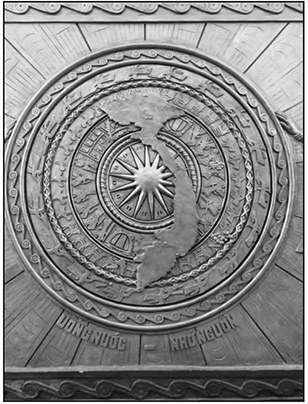
Figure 1. Sculpted mural at Cha H Quc, Ph Quc, Vit Nam (H Quc Pagoda, Ph Quc Island, Vit Nam). This section of the mural includes three cities: H Ni (National Capital of reunified Vit Nam, 1975 to the present), Hu (Imperial Capital, 18021945), and H Ch Minh (capital of French Cochinchina and later the Republic of South Vit Nam, 19551975). Underneath the map is the following inscription: ng nc nh ngun. Courtesy of the author.
The research that makes up the focus of this book received generous support from American Universitys College of Arts and Sciences in the form of both a Robyn Rafferty Mathias/Mellon Grant (2007) and a Doctoral Dissertation Fellowship (20082009). Later, while on the faculty of the Department of Anthropology at American University, I also received invaluable support in the form of the outstanding Jeanne Hanna, who was my research assistant during the drafting of this manuscript (20142016). When I was in a dark mood about ever seeing this work completed, it was Jeannes enthusiasm for my research topic, coupled with the connections she drew to her own research, which often inspired me to press on. That and her sharp wit, incisive political commentary, and ready laughter.

